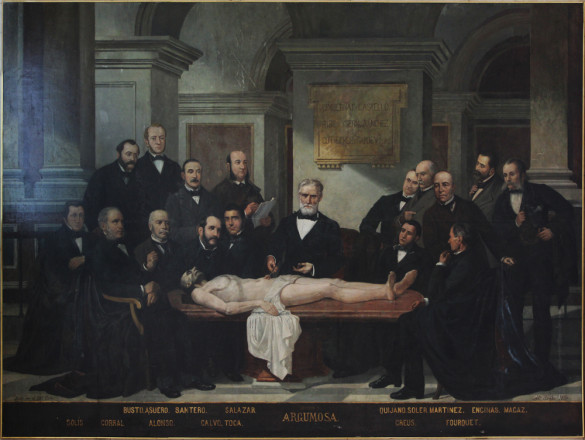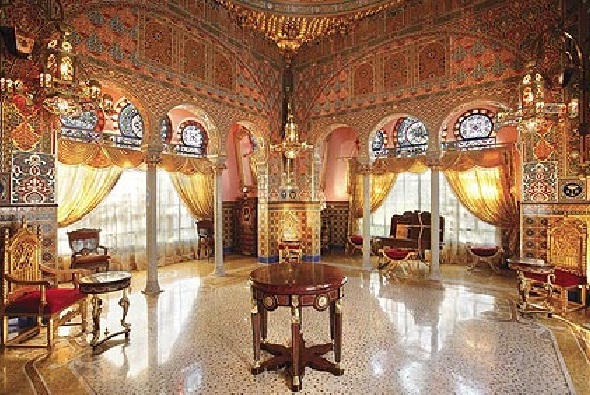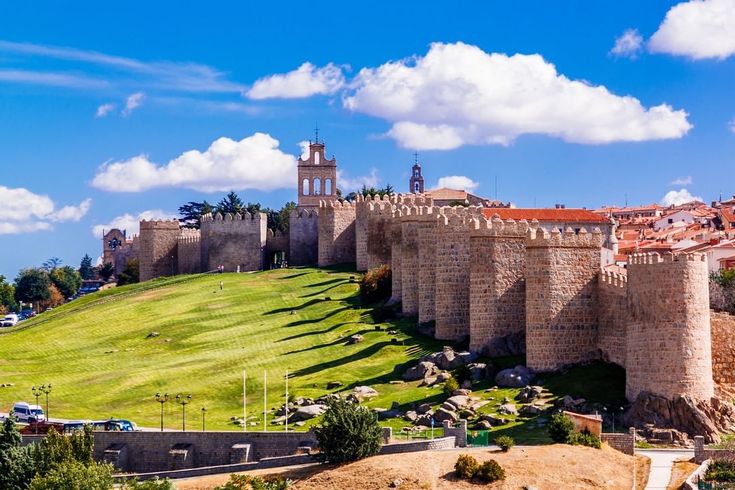The World According to Putin
Tuesday, March 29, 2022
When Vladimir Putin justified his annexation of Crimea on the grounds that he owed protection to 'Russian speakers' everywhere, The Economist pointed out that since linguistic borders do not match those of states, it would lead to total chaos. Naturally, The Economist said that this approach to international relations betrayed a deplorable conservatism and decided to redraw the world’s boundaries according to Mr Putin’s ridiculous principles:

 1
Like
Published at 9:05 PM Comments (0)
1
Like
Published at 9:05 PM Comments (0)
Madrid's Museum of Anatomy
Thursday, March 24, 2022

An incredible collection of anatomical models, mummified body parts, and human bones can be discovered in one of the world's oldest universities.
The Universidad Complutense of Madrid is one of the oldest universities in the world. Its story begins as far back as 1293 when the Archbishop of Toledo was granted a charter by King Sancho IV of Castile to found a “studium generale.” Two hundred years later, in 1499, Pope Alexander VI granted a papal bull, which expanded the Complutense into a full university.
Today, the best reason to visit the University is its Museum of Anatomy, “Javier Puerta,” created in 1787 by royal decree of King Charles III, who was known for his contributions to science and research.

Part of the college of medicine, the museum is made up of anatomical models, mummified and artificial body parts, and three sculpture collections. The wax polychrome sculpture collection displays a series of anatomically precise wax models, representing the stages of pregnancy from conception to childbirth, the oldest of which dates back to 1794. The plaster polychrome sculpture collection is essentially a collection of plaster sculptures of human body parts. The ominous-sounding bone collection is comprised of thousands of skulls and two skeletons.
One of these, which dates back to the Spanish War of Independence (1807-1814), is the skeleton of a French farmer and grenadier who, due to the mercury salts in his bones, is speculated to have been killed by mercury poisoning. The other is the skeleton of the so-called Extremeño Giant, said to have been brought to the museum alive by Pedro Gonzalez de Velasco, the museum’s director at the time.

To be sure that the museum is open at the time you'd like to visit, give them a call at +34 913 94 13 74, or request an appointment by email at fviejo@med.ucm.es.
 1
Like
Published at 8:55 PM Comments (0)
1
Like
Published at 8:55 PM Comments (0)
The 1:2 Replica of The Giralda in Tarragona!
Friday, March 18, 2022

Driving along the road ‘N-340’ southbound, just entering the province of Tarragona you’ll find the town of L'Arboç (Baix Penedès), which boasts a scaled replica (1:2) of the famous Giralda in Seville, which was begun in 1184 by the then Muslim rulers of Spain and was designed by mathematician and astronomer Jabir ibn Aflah.
The charming legend around the origin of the construction of this replica of Seville’s ever-famous minaret-bell tower is far more popular than the true story, even amongst many of the local town’s inhabitants.
The false story about the origin of the Giralda of L’Arboç tells the story of a married couple who had emigrated from Seville and after several years of living there, greatly missed their Giralda, the emblem of their hometown. Sighing day and night and longed ever so much to see it again. The years passed and thanks to a lot of hard work they had amassed a great fortune, but their businesses were so important that it was impossible to return to their homeland. So they thought that if they could not go to live next to their treasured monument, they would have to bring it to them, and they commissioned an exact scaled replica so they could enjoy it every day for the rest of their lives.



But obviously, this story, full of romance and nostalgia, is not exactly true but not far from it. The true story behind why there is a replica of the Giralda of Seville in the province of Tarragona is as follows:
This striking monument which is more than a century old was a tribute that Joan Roquer i Marí and Candelaria Negravernis wanted to pay for their trip to Andalusia on their first wedding anniversary. Extravagant, yes, but the young couple had received in 1886 a considerable fortune from the girl’s Indian uncle who had made his fortune in America. This led them to invest in several cultural projects, including the construction of the Teatro Romea in Barcelona or the Arbosense Theatre, originally the hometown of Joan, although he resided in Barcelona.
Their healthy economic position led them to travel to Andalusia and enjoy the buildings left by the Muslims during the time of Al-Andalus.
After several years of travel and business, in 1898 they decided to buy a plot of land of considerable size and commissioned a replica of those places that had fascinated them during their travels around the south of Spain.
A year later construction began, which lasted until 1907 and opened a year later (the ‘Giralda’ was finished in 1902). But not only the minaret was built there. Inside you can find a replica of the ‘Patio de Los Leones’ from the Alhambra in Granada and a lounge covered by a Byzantine dome lined with 30 kg of gold leaf, a copy of the ‘Hall of Ambassadors’ found in the Real Alcazar of Seville.

Thanks to the restless spirit of their owners, in the years following the Giralda of Arboç became a meeting place for characters linked closely to arts and culture, where events and music festivals were held. Today it is a convention centre where you can even hold a wedding.
 1
Like
Published at 8:14 PM Comments (0)
1
Like
Published at 8:14 PM Comments (0)
Among the Most Beautiful Medieval Cities in Europe
Thursday, March 10, 2022

The vestiges of medieval times are distributed throughout the entire Spanish geography. Between the 5th and 15th centuries, castles, walls and other buildings were built in Spain that is still present today and that, in addition, represent a fundamental tourist attraction for certain towns and cities. Ávila is a clear example of this and its medieval attributes have caught the attention of 'TravelMag', a prestigious online magazine specializing in travel.
In an article published on February 15 on "The most beautiful medieval cities in Europe", the magazine's experts included Ávila in the ranking, and it was also the first city mentioned in the publication.
One of the requirements to be part of the list is to have very well preserved medieval elements, and Ávila more than achieves this. This small city in Castilla y León has a spectacular medieval wall built between the 11th and 13th centuries. It has a perimeter of 2,516 metres, has 87 towers, nine gates, two gatehouses and 2,500 merlons (vertical projections on the top of the wall that allowed the defender to take shelter)

As if this were not enough, in 'TravelMag' they emphasize that the imposing wall surrounds an ancient city full of churches, convents and basilicas built between the 12th and 16th centuries. One of them is the Ávila Cathedral. This gives rise to a mixture of Romanesque and Gothic elements.
The wall is founded on rock, and granite was used in its construction. Various levels of robustness are observed in its different parts. This is so because the eastern front was raised first, the one that was most vulnerable at the time due to the lack of a natural defence against attacks. Therefore, its structure is more solid with walls three meters thick and 12 meters high.
In the original design, additional defensive elements were added, such as moats and barbicans (types of windows through which cannons or arrows were fired), but with the disappearance of the constant danger of war in the 16th century, they were eliminated.

 Over time, repairs were carried out to maintain its majestic appearance. On March 24, 1984, it was declared a National Monument and in 1985 UNESCO declared the city of Ávila World Cultural Heritage. Over time, repairs were carried out to maintain its majestic appearance. On March 24, 1984, it was declared a National Monument and in 1985 UNESCO declared the city of Ávila World Cultural Heritage.
Today you can visit the wall at different times. In winter, from 10:00 a.m. to 6:00 p.m every day except Monday. In summer from 10:00 a.m. to 8:00 p.m every day. The price of the individual ticket is €5, with a reduced option of €3.5. In addition, access is free on Tuesdays from 2:00 p.m. to 4:00 p.m. except for holidays or the eve of holidays through the Puerta del Alcázar.
 2
Like
Published at 8:52 PM Comments (0)
2
Like
Published at 8:52 PM Comments (0)
Spam post or Abuse? Please let us know
|
|